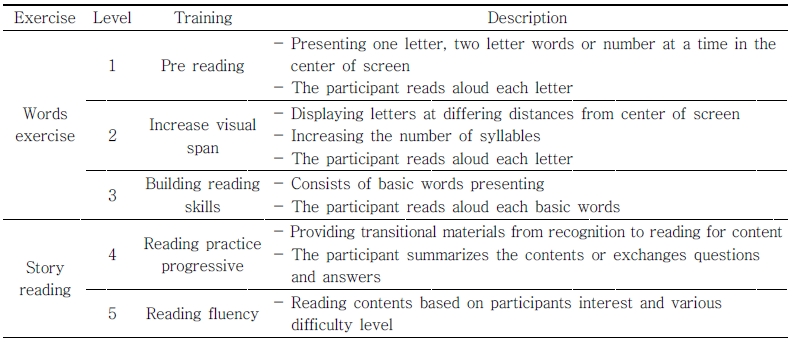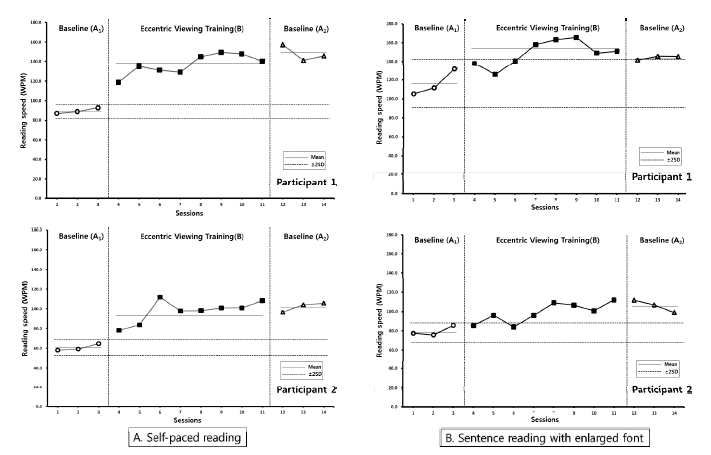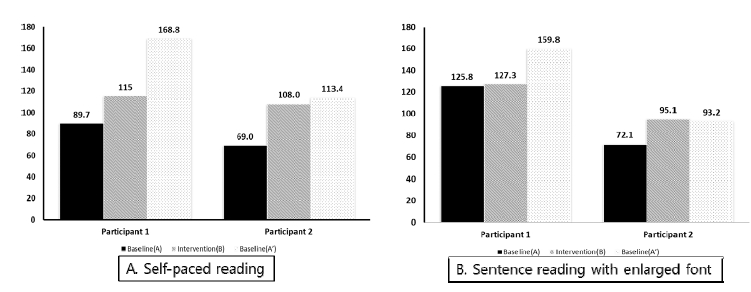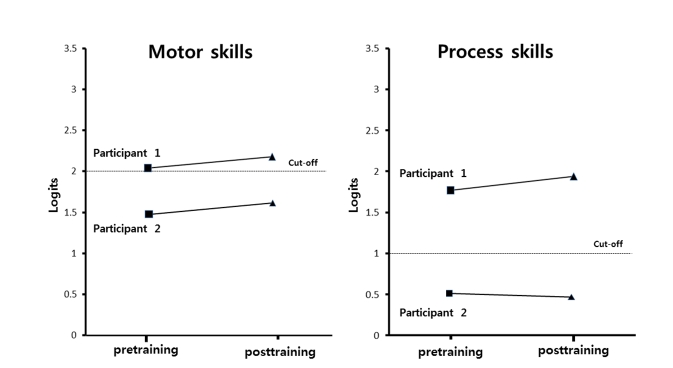Introduction
People with central scotomas caused by macular degeneration, cone dystrophy, or optic nerve damage show depressed vision that corresponds with the point of fixation and central vision problems(Scheiman, Scheiman, & Whittaker, 2007). Loss of central vision leads to difficulties in various Activities of Daily Living(ADL) such as reading, writing, shopping, eating, doing housework, or driving(Cummings, Whittaker, Watson, & Budd, 1985; Legge, Rubin, Pelli, & Schleske, 1985; Scheiman et al., 2007). Reading is the most significantly influenced by central vision. Thus, ADLs which are related to reading such as using a smartphone and checking the label or expiration date on food, or the date on an invitation are very likely to be affected by central scotomas (Smallfield, Clem, & Myers, 2013). Individuals with central scotomas cannot use central vision, but their peripheral vision generally remains intact (Scheiman et al., 2007). Many studies have proposed that reading can be trained by eccentric viewing, using other relatively good retinal loci for replacement of the eye’s central vision(Palmer, Logan, Nabili, & Dutton, 2010; Reeves, Harper, & Russell, 2004; Vukicevic & Fitzmaurice, 2009).
Eccentric viewing training is a process that is used to train the healthy peripheral retina called Preferred Retinal Loci(PRL) to replace the central vision(Von noorden & Mackensen, 1962). Since Holcomb and Goodrich(1976) reported that people can learn eccentric viewing through training, there have been a series of research findings that prove the positive effects of eccentric viewing training for reading. In some studies, research methods for eccentric viewing training vary, but generally share two essential elements(Frennesson, Jakobsson, & Nilsson, 1995; Nilsson, Frennesson, & Nilsson, 2003; Palmer et al., 2010; Vukicevic & Fitzmaurice, 2005). The first is determination of the PRL to be used instead of central vision prior to training. Individuals with central scotomas can learn to use PRL, which constitute the optimal location for eccentric viewing as determined by experts. The second element is undergoing repetitive training for acquiring eccentric viewing with determined PRL (Scheiman et al., 2007; Moyer & Layton, 2011). At the early stage of training, eccentric viewing with PRL may seem deliberate or unfamiliar; however, continuous training will gradually make the participants more familiar with automatic eccentric viewing.
Due to the dissemination of computers from the 1990s, there has been an increasing number of low-vision rehabilitation programs that use computer software(Frennesson et al., 1995; Nilsson et al., 2003; Vukicevic & Fitzmaurice, 2009; Moyer & Layton, 2011). Software-based eccentric viewing training can consistently stimulate visual training to reinforce PRL, facilitate configuration and difficulty adjustment, and immediately show the training outcome after the end of each session, thereby attracting high involvement in training(Nilsson et al., 2003; Scheiman et al., 2007). Characters for specific language are used as the stimulus for eccentric viewing training generally because the main purpose of eccentric viewing training is to improve the reading skill(Frennesson et al., 1995; Nilsson et al., 2003; Tarita-Nistor, Gonzalez, Markowitz, & Steinbach, 2009; Palmer et al., 2010; Chung, 2011). As most computer programs for eccentric viewing training are in English, those programs are difficult to use in other countries that have completely different language system, special features and culture such as Korea or Japan. Therefore, it is necessary to design an eccentric viewing training program based on each language’s characters that considers its unique features.
The purpose of this study was to apply eccentric viewing training software based on specific language characters to individuals in clinics in Korea to determine whether it is effective in improving reading speed and to analyze whether it influences ADL. Furthermore, this study was intended to capture the various aspects of an effective eccentric viewing training program in detail for each participant through single-subject research.
Methods
1.Participants
Two adult patients with central scotomas who diagnosed with macular degeneration or optic neuropathy, volunteered to participate in this study. The participants’ ages were 57 and 60. The duration of the visual impairment lasted for 2 years or more, and participants had no cognitive deficits. The participants’ PRL were between 1 and 2 o’clock (superotemporal) and 10 and 11 o’clock (superonasal), respectively. Participant 1 was a tour guide and golfer, and Participant 2 was a professor of graduate school. The demographic characteristics of the participants are provided in Table 1.
The protocol and consent form for this study were approved by Yonsei University Wonju Institutional Review Board (IRB no. 1041849-201310-BM- 015-02). Written consent was obtained from the participants after the nature of the study, the possible consequences, and the benefits of the intervention were explained.
2.Intervention task
To reinforce eccentric viewing with the steady-eye strategy, the researcher converted the MagnaFlyer program into Korean stimulation. The MagnaFlyer program was produced to reinforce eccentric viewing with the steady-eye strategy using the RSVP(Rapid Serial Visual Presentation) method on computer software coproduced by SoftOlogy IdeaWorks, and Ensight Skills Center in the United States(Moyer & Layton, 2011). RSVP is a method in which each word in a sentence is shown one at time in the same place and replaced automatically at a fixation interval(Chung, 2011). Hardware for the equipment used in this experiment, included a personal laptop computer system which is a 17-inch flat-screen monitor (1024 × 768, 72Hz), a USB-connected keyboard, and a wired microphone. The eccentric viewing training programs of MagnaFlyer are consisted of word exercises and story reading. The difficulty level in all MagnaFlyer eccentric viewing training programs can be fulfilled by increasing the number of characters or syllables or by increasing the speed of RSVP. The Korean stimuli used in restructuring the program were converted to match the characteristics of the stimuli used in each phase of the MagnaFlyer program(Table 2). In this study, the eccentric viewing training was conducted at a regular interval for 30 minutes per session using a one-to-one training method with the researcher and participant. The participant was instructed to close his eyes for 2~3 minutes for a break in the middle of the program before the evaluation, in case he was experiencing eye fatigue. The speed of the first stimulation in eccentric viewing training was set up as the average speed for the baseline short-sentence reading. The stimulation speed for later training began from the final reading speed of the previous session. The stimulation speed of eccentric viewing training was 3 wpm in the word exercise and 25 wpm in the story-reading exercise. When the reading was at least 90% correct, the difficulty of the (testing) level was increased.
3.Procedure
This study used a single-subject A-B-A research withdrawal design that replicated one baseline phase followed by the intervention. Such a design allowed for identification of the replication in effectiveness over a second baseline(Portney & Watkins, 2009). The baseline periods (A) are consisted of three sessions each, and the intervention period (B) followed after A baseline periods for eight sessions. During the baseline periods, data were collected without eccentric viewing training. The intervention periods (B) are consisted of eccentric viewing training with the MagnaFlyer program. During the 14 sessions, participants were assessed based on their reading speed of short sentences for fixed hours each day. Assessment of reading speed of lengthy sentences was conducted at the end of the first and the second baselines, after the fourth session of the intervention period. Measurement of reading speed to determine the effects of eccentric viewing training in this study was carried out by measuring the reading speed of short and long sentences, applying 1) self-paced reading by RSVP software and 2) reading sentences with enlarged font using PowerPoint. Self-paced reading was used to identify reading ability with eccentric viewing, and sentence reading with enlarged font was used to examine transferring effects according to reading ability with eye movements. A collection of 200 sentences which was selected from a Grade 1 middle school Korean-language textbook, was used to measure short sentence reading speed(Song, 2008). All words in each sentence were limited to two to four syllables, with a total number of 10 syntactic words per sentence. A collection of six paragraphs in Kang(2005) for analyzing the reading efficiency, was applied in this study for measurement of long-sentence reading speed. All paragraphs were consisted of around 250 characters extracted by two Korean-language teachers from schools for the blind.
Time and reading errors were measured until the participants finished processing all words in the sentence for determining reading speed. The number of target words read by each participant (the total number of syntactic words read – the number of syntactic words read with errors) was divided by the reading time to determine the reading speed which represents the average number of syllables (syntactic words) per minute (WPM: Words Per Minute).
In order to examine the reading activities and ADL function of the participants, Canadian Occupational Performance Measure(COPM) and Assessment of Motor and Process Skills(AMPS) were used at the end of every first and second baseline periods( Kirkley & Fisher, 1999; Law et al., 1994).
4.Data analysis
The results of this study were analyzed using the two Standard Deviation(SD) band method on short-sentence reading speed. Two successive reading speeds in the training periods outside the 2 SD bandwidth of the baseline periods constitute an effective intervention. The scores for long-sentence reading speed, COPM and AMPS across the pre- and posttraining baseline periods were visually analyzed using graphs.
Results
The reading speed data on short-sentence of Participants 1 and 2 which was measured by the two methods, showed a significant improvement, as both data from the intervention period and post-training baseline period deviated more than 2 standard deviations from the pre-training baseline period(Figures 1). After four to five sessions of intervention for participants, reading speed increased to a stable value within a 15% range of average measurement. The long-sentence reading speed with self-face and enlarged font of Participant 1 and 2 after eight training sessions had increased more than at the baseline period(Figure 2).
The results from COPM by the participants are shown a significant improvement in the performance and satisfaction of reading-related activities such as ‘reviewing the reports by using the word processor’, ‘reading subtitles on TV or movies’, or ‘Reading documents with computer software’ from the baseline period(Figure 3). The score of increase on performance for all participants were 2.0 points, which indicated remarkable change in clinical practice. However, there was no score change in performance and satisfaction of other ADL such as ‘Cleanliness during personal hygiene’ or ‘Identification of unfamiliar objects’ on pre- and post-training.
In the results of AMPS scores, the scores of increase on the motor and process skills for Participant 1 and 2 before and after the intervention, were 0.14, 0.17 and 0.19, -0.03 logits, but there was no clinically significant change(Figure 4). The motor and process skills scores for Participant 1 were both sufficient for safe living in the community without help, but those of Participant 2 were not sufficient and required for a little help for safe and independent living in the community.
Discussion
The purpose of this study was to examine whether the eccentric viewing training program by MagnaFlyer in Korean based on other language is effective for improving reading speed, reading activities, and other ADL function in individuals with central scatomas, by using a single-subject research design.
The visual analysis of the reading speed of this research participants showed that reading speed increased significantly in both self-paced reading and reading the enlarged font after eccentric viewing. Chung(2011) reported that reading speed increased by 53% in individuals with central scotomas when applying the RSVP method. This result was due to the fact that adaptability of retina perceived as PRL, which was reinforced by repetitive stimulation and eyeball movement such as jumping and returning to other words decreased, as all words were presented in the same location while reading(Arditi, 1999; Chung, 2011; Chung, Mansfield, & Legge, 1998; Palmar et al., 2010; Song, 2008). There was also an improvement in the speed of sentence reading with enlarged font, which was measured to determine whether the effect of the eccentric viewing training was maintained when participants were reading the printed texts. The eccentric viewing training program is generally consisted of habituating the way of seeing with eyes stably fixed and then reinforcing the eye movement(Scheiman et al., 2007). The findings of this research imply that although the eccentric viewing training with eye fixation did not accompany eye movement, still the effect is maintained even when participants are reading the printed text. In addition, the result of self-paced reading speed in this study showed the highest level of increase in the first two to three sessions which were at the beginning of training. This result implies that considering the adaptation of the repetitive training period of four to five sessions by implementing a systematic eccentric viewing program in clinical practice in the future, it is necessary in order to make the participants more familiar with the new method for improving their general sentence-reading ability.
Another key implication related to the increase in reading speed was that the eccentric viewing training program by Magnaflyer software was effective for improvement on reading even when it was based on Korean. Eccentric viewing training software in previous studies were conducted overseas in English, making it difficult to apply them to non-native English speaking low-vision individuals like Korean. Even though Korean characters have many strokes, requiring high concentration to read, and can cause delays, the results of this research show reading ability can be improved through the eccentric viewing training program(Han, 2004). As this study organized a systematic training program that distinguished similar Korean texts according to difficulties in level for low-vision individuals, the program may lead to a significant improvement in reading speed. Korean has a completely different form and characteristics than the English alphabet, so it is necessary to establish a separate eccentric viewing training program that considers such characteristics to apply the training in Korea. Thus, among various eccentric viewing programs, the MagnaFlyer program package which can convert visual stimulation for training into Korean, was selected and applied. As each stage was organized with consideration for the Korean difficulty levels, basic vocabulary, and vocabulary level of low-vision individuals, the training program used in this study, can be used systematically in Korean clinical practice(Han, 2004; Kim, Hong, & Kim, 2009). This study is significant in that it showed the applicability of the eccentric viewing training to rehabilitation of low-vision individuals in other countries that not using English.
The COPM results for all participants showed a clinically significant change, with an increase of at least 2 points in performance for all reading-related items, such as using a word processor or reading a document with a magnifying device, as well as an increase in satisfaction. The biggest daily life problem for low-vision individuals with central scotomas is reading activities(Han, 2004; Smallfield et al., 2013). The eccentric viewing training program can be applied to enhance the quality of life for individuals with central scotomas by improving ADL related to reading, which is their biggest challenge. However, there was no change in other ADL. In particular, there was no significant improvement in the evaluation of ADL that observed direct tasks such as AMPS. This may be due to the fact that eccentric viewing training was not accompanied by other intervention methods such as other training programs, environmental modification, or training in the use of tools. Occupational therapists are experts who are specialized in treatment and evaluation of ADL for individuals with disabilities in the traditional rehabilitation field(Scheiman et al., 2007). Occupational therapists must make efforts to resolve the issues in ADL and task performance for low-vision individuals. Moreover, various programs, including the eccentric viewing training program in this study, must be developed.
There are limitations in terms of generalizing the findings of this research, as it was a single-subject experimental study of only two individuals. Furthermore, the effect of the eccentric viewing training was insignificant for activities other than reading. Thus, it is necessary to conduct further research that can produce overall effects on ADL, by carrying out environmental interventions along with eccentric viewing training. In this study, participants reported the convenience of seeing object with a fixed gaze, using the PRL for two to three sessions after training. However, whether or not participants were using a fixed gaze could not be determined. Future studies of eccentric viewing training could use an eye-tracking system to measure eye movement as a dependent variable.
Conclusion
The results of this research for two participants through the eccentric viewing training based on specific language characters showed that reading speed increased and reading-related ADL, thereby suggesting that was an effective intervention method for improvement in the reading skills of individuals with central scotomas. To more clearly estimate the effects of eccentric viewing training based on specific language characters, stricter research protocols trial must be used in future studies.







